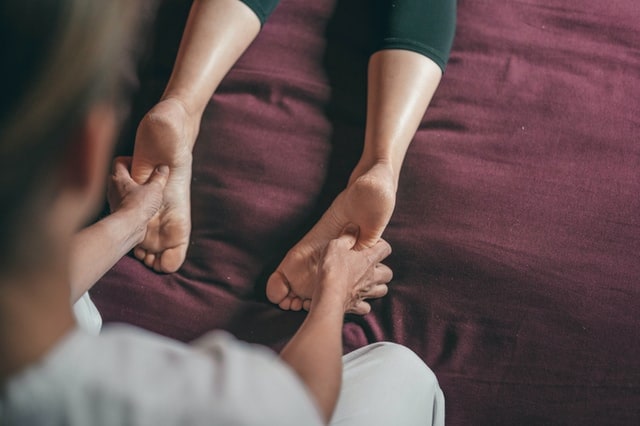Our feet do a lot for us. They help us move from point A to point B, but they also enable us to dance, run and show off on-trend sneakers! So it comes as no surprise that when they’re sore and in pain, we feel pretty helpless. Hobbling around all day and wincing in pain isn’t a good look! One of the culprits that makes us suffer so much is heel pain, of which plantar fasciitis is the most common. The good news is that this condition is reversible with early treatment.

Heel and toe, heel and toe
When you experience heel pain, it’s crucial that you see a podiatrist as soon as possible. After all, they are responsible for diagnosing, treating and preventing conditions related to our feet and lower limbs.
There’s a common misconception that only the elderly need to see a podiatrist. Plantar fasciitis is a good example of when this may not be the case. In fact, plantar fasciitis affects one in ten people. About 10% of those affected sustain the condition from running. So this foot condition definitely isn’t just one for the elderly!

Plantar what?
Heel pain of the plantar fasciitis variety occurs when there is severe irritation and inflammation of the plantar fascia. The plantar fascia is the piece of thick tissue that runs along the bottom of our feet. It’s essentially the ligament that creates the arch in our feet by connecting our toes to our heel bone.

The main indicator of plantar fasciitis is pain. This pain is generally under the heel and can be either a dull ache or a sharp stabbing sensation. The pain is often more intense after intense activity, prolonged standing or sitting and especially during those first few steps in the morning.
Our heels may also be a little swollen and the bottoms of our feet achy and hot.
What causes plantar fasciitis?
The plantar fascia stretches along the sole of your foot to provide support and absorb shock. If it placed under pressure for long durations, it is likely to become stiff and develop micro-tears, causing swelling and inflammation.
There are some factors that make certain people more prone to plantar fasciitis. These are:
Lifestyle: Those who need to remain on their feet for long hours may suffer from plantar fasciitis. Traffic cops, store staff, sports people or athletes, flight crew, and other professions often find it helpful to use shoe inserts to reduce the pressure on the feet.

Overweight or obese people: If your feet need to bear your weight for long stretches and you’re overweight, your plantar fascia muscles will become sore.
Habits: Plantar fasciitis can be caused by some forms of exercise like running or dance, wearing high heels all day, standing for hours on hard or unpadded surfaces, or incorrect walking posture.
For plantar fasciitis that has just begun, a simple plan of ice packs and rest may be enough to remedy the pain. If it becomes worse, does not go away, or flares up regularly, you should consult a doctor.
Home remedies for plantar fasciitis
If your pain is mild, there are some plantar fasciitis treatment options to try at home to help ease the discomfort.
Wear comfortable shoes

Wearing high heels or hard uncomfortable shoes can put pressure on the soles of your feet. If you have to wear them as part of your professional dress code or uniform, talk to your doctor about shoe inserts to ease the pain. If you have the option to wear something else, choose more comfortable shoes or carry a pair that you can change into.
Put your feet up
The first step in plantar fasciitis treatment is to rest it and allow it to heal without needing to bear weight. Spend as much time as you can with your feet raised. If you have to go to work, try to arrange a foot stool under your desk.
Use cold therapy
For any inflammation of the muscles, an ice pack is one of the first things you can do to reduce the swelling. For plantar fasciitis treatment, many doctors recommend using ice packs or soaking your feet in water with ice cubes floating in it.
Gentle stretches
You might not be able to do this when your plantar fasciitis pain has flared up but when your feet aren’t aching, maintain a regime of stretching to strengthen the muscles and keep them soft and flexible.
Orthotic aids
Talk to your doctor about using aids like arch inserts or athletic tape to stabilise the feet and provide cushioning.
Consult a physiotherapist
This isn’t a home remedy but a physiotherapist may teach you a series of stretches or exercises that you can do at home on a regular basis. These exercises complement your plantar fasciitis treatment and prevent it from coming back.
Help stop the hurting
Plantar fasciitis is treated and diagnosed by podiatrists. While treatment may differ from patient to patient, some heel pain and foot mobility treatments include pain relief medicine, steroidal anti-inflammatories, foot exercises, rest and night splints in conjunction with orthotics.
Some people see their physiotherapist first as they can perform foot assessments and biomechanical correction. However, your physiotherapist may recommend you see a podiatrist if you haven’t already or may suggest that you get a massage or invest in orthotics.

If you’re experiencing heel pain, book a podiatry appointment with Avaana to help heal your heels!



